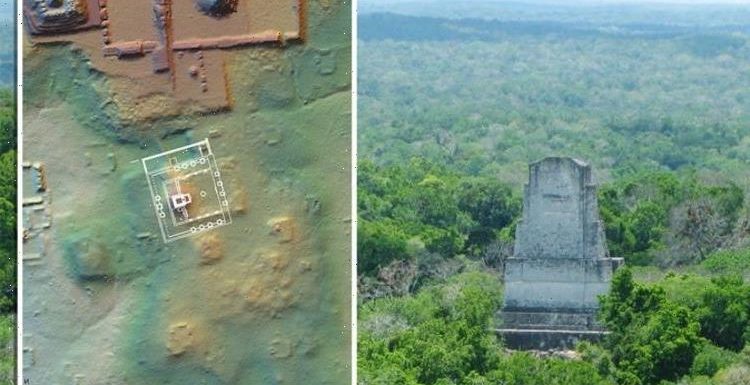
Tikal: Shocking discoveries made at Ancient Mayan City
We use your sign-up to provide content in ways you’ve consented to and to improve our understanding of you. This may include adverts from us and 3rd parties based on our understanding. You can unsubscribe at any time. More info
The groundbreaking discovery was made at the ancient ruins of Tikal, a complex of more than 3,000 Maya structures in Guatemala’s Tikal National Park. Archaeologists have been exploring the site since the 1950s, cataloguing and documenting one of the world’s most fascinating sites. But if recent discoveries in the wilderness surrounding Tikal prove anything, it is that the site has many more mysteries waiting to be uncovered.
According to a study published today in the journal Antiquity, a team of international researchers has uncovered a previously unknown part of the ancient Maya city.
Using light detection and ranging software (lidar) technology, which can penetrate the ground, the Pacunam Lidar Initiative exposed a nearby area of hills to be long-hidden ruins.
The discovery was led by Stephen Houston, a professor of anthropology at Brown University, and Thomas Garrison, an assistant professor at the University of Texas at Austin.
Even more surprisingly, the newly-found neighbourhood appears to have been modelled on the architecture of Teotihuacan, the biggest and most powerful of Mesoamerica’s ancient cities.
The site has since been analysed and excavated by Guatemalan archaeologists led by Edwin Román Ramírez, shedding new light on the influence Teotihuacan exerted on the Maya civilisation.
READ MORE: Noah’s Ark hunters claim they’ve found ‘shape matching Bible description


Professor Houston said: “What we had taken to be natural hills actually were shown to be modified and conformed to the shape of the citadel — the area that was possibly the imperial palace — at Teotihuacan.
“Regardless of who built this smaller-scale replica and why, it shows without a doubt that there was a different level of interaction between Tikal and Teotihuacan than previously believed.”
According to the experts, the two cities could not be any more different.
Tikal, also known as Yax Mutal, was a fairly small city where “you could have walked from one end of the kingdom to the other in a day, maybe two.”
Teotihuacan, on the other hand, was a much grander city that was likely the central hub of a Mesoamerican empire.
Scholars believe the pre-Columbian city boasted a population of 125,000 and was the biggest of its kind in the region.
Today, the ruins of Teotihuacan are found in the Valley of Mexico, in Mexico State.
Maya: Archaeologists discover Mayan royal palace

Very little is known about the actual residents of the city, though it is clear their influence stretched far beyond the borders of their impressive capital.
Tikal was conquered by Teotihuacan around the year 378 AD, and there is evidence of cultural mixing between the second and sixth centuries AD.
Evidence suggests Maya elites and scribes living in Teotihuacan imported a number of cultural practices, such as burial rituals and architectural cues.
And based on the latest discoveries at Tikal, Teotihuacan’s influence on Tikal may have been much stronger than previously thought.
Professor Houston said: “The architectural complex we found very much appears to have been built for people from Teotihuacan or those under their control.
“Perhaps it was something like an embassy complex, but when we combine previous research with our latest findings, it suggests something more heavy-handed, like occupation or surveillance.


“At the very least, it shows an attempt to implant a part of foreign city plan on Tikal.”
The excavations have so far confirmed the buildings were raised using mud plaster, instead of the traditional Maya limestone.
And it appears as though they were built as smaller replicas of the structures found in Teotihuacan.
Professor Houston said: “It almost suggests that local builders were told to use an entirely non-local building technology while constructing this sprawling new building complex.”
At a nearby complex of buildings, the excavators also found evidence of a possible conflict – projectiles crafted by the Maya and green obsidian, which was favoured by the people of Teotihuacan.
The archaeologists also found evidence of unusual human burials practices, which resembled those found in the centre of Teotihuacan.
Professor Houston said: “Excavations in the middle of the citadel at Teotihuacan have found the burials of many individuals dressed as warriors, and they appear to have been sacrificed and placed in mass graves.
“We have possibly found a vestige of one of those burials at Tikal itself.”
The archaeologists will resume their excavations at Tikal later this autumn.
Professor Houston added: “Before European colonization of the Americas, there were empires and kingdoms of disproportionate influence and strength interacting with smaller civilizations in a way that left a large impact.
“Exploring Teotihuacan’s influence on Mesoamerica could be a way to explore the beginnings of colonialism and its oppressions and local collusions.”
Source: Read Full Article